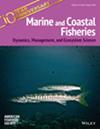Stock-specific spatial overlap among seabird predators and Columbia River juvenile Chinook Salmon suggests a mechanism for predation during early marine residence
Abstract
Objective
Because predation is thought to be the primary source of natural mortality for juvenile salmon first entering the ocean, we sought to identify regions where, on average, stock-specific spatial overlap between the distribution of threatened and endangered juvenile Chinook Salmon Oncorhynchus tshawytscha and abundant fish-eating seabirds (common murres Uria aalge and sooty shearwaters Ardenna grisea) suggests the greatest potential for ocean predation risk to juvenile Chinook Salmon.
Methods
The relative abundance and spatial distribution of seabird predators and juvenile Chinook Salmon were quantified as part of long-term ecosystem surveys during May 2003–2012 and June 2003–2022. Genetic stock identification methods were used to assign individual fish to their respective stock groups. Stock-specific species distribution models then generated maps and indices of average annual spatial overlap between predators and prey within the survey area.
Result
There is unequivocal evidence for spatial overlap between common murres, sooty shearwaters, and five genetic groups of interior and lower Columbia River juvenile Chinook Salmon. We found strongly positive (≥0.70) spatial correlations between predator and prey densities in both May and June, although spatial overlap was, in general, greater during May. The region of highest spatial overlap occurred on the inner continental shelf between the Columbia River mouth (46.2°N) and Grays Harbor (47.0°N), a region at the beginning of the juvenile salmon migratory pathway that is strongly affected by freshwater outflow from the river.
Conclusion
Our findings support the idea that ocean avian predation during early marine residence has the potential to affect marine survival of juvenile Chinook Salmon and should be further investigated to better inform and implement ecological models and possible recovery actions for Chinook Salmon populations of the Columbia River basin.


 求助内容:
求助内容: 应助结果提醒方式:
应助结果提醒方式:


